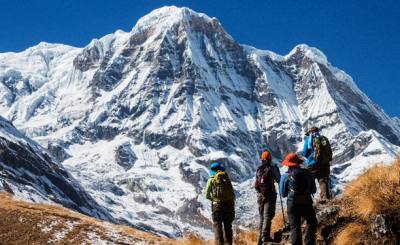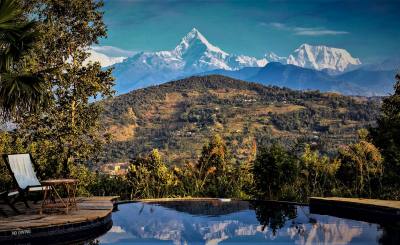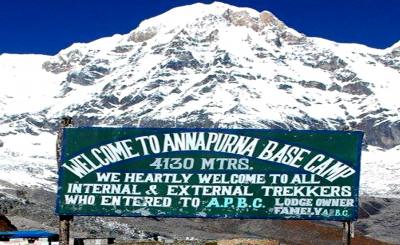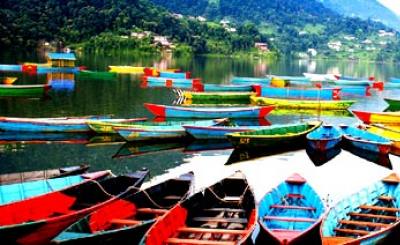Journey to the Everest Base Camp
Mount Everest, at a soaring height of 8,848.86 meters, has cast many aspiring climbers under its spell. However, not all attempts to surmount the legendary mountain have been successful. So, many of the wise climbers, considering their strength, expense, and time restrictions, often choose to embark on the Journey to the Everest Base Camp (EBC) Trek instead. How would you like to have your footprints marked on the foothills of the tallest mountain in the world while embracing the best glance of Everest from Kala Patthar? Located at an altitude of 5364 meters, EBC Trek basks in its own glory of being the outset station to the mighty Everest (8848.86 m). With towering white masses of magisterial stature, four of the ten highest peaks in the world (Everest, Makalu, Lhotse, and Cho Oyu) are concentrated in this region. The majority of the trek involves walking through the Sagarmatha National Park, a coveted UNESCO World Heritage Site, which offers the likes of unique flora and fauna. The Sherpa hospitality, culture, monasteries, and villages are other commendable features of the Everest Base Camp Trekking.
Routes to Trek Everest Base Camp.
The most common and direct route to Everest Base Camp (EBC) Hiking is the classic Solukhumbu trek. The journey kicks off at Lukla and proceeds towards Namche, the “Gateway to Everest.” A day or two is spent here for acclimatization. Tengboche Monastery, which is deeply sacred to the Sherpa ethnicity, is another highlight of this trek. Following the path to reach Kala Patthar, the highest point of the trek, magnificent views of Mt. Everest, Khumbu Glacier, and Icefall are relished, which cannot be experienced from the Everest Base Camp.
The Alternative Routes to Everest Base Camp Are:
- Best Everest Hiking Trip in Nepal: The Best Everest Hiking Trip in Nepal begins slightly west of Namche towards Gokyo Ri. The villages of Gokyo are one of the highest human settlements, and the place is even more famous for its turquoise lakes. From Gokyo, you cross over Cho La Pass (5420 m) and descend to Lobuche and head towards EBC. The only flipside is that the weather is unpredictable.
Best Seasons to Trek Everest Base Camp.
The months from March to May and September to December are the most convenient times to commence the journey to the Everest Base Camp Trekking. Late September–November and February–May are busy trekking periods that provide stable weather conditions, less cloud cover, vivid visibility, and, most importantly, an endurable temperature. Spring offers the bloom of rhododendrons and allows a greater length of daylight for exploring various places with an upgrade in temperature of -6 degrees Celsius compared to a freezing -15 degrees Celsius occurring at other seasons. Autumn supplies clear skies and post-monsoon topography that gives a verdant edge to the picturesque landscape. There is also heat haze during this time. It is possible to trek during winter (January–February) when the trails are less crowded, but it is not recommended as the temperature drops to a wicked -30 degrees Celsius.
Physical Fitness.
The trails to Everest Base Camp are challenging and have an alarming altitude and make it a daunting task for trekkers with an average fitness regime. Prior to commencing the journey, it is better to take up a workout schedule that gets your physique ready for the trek. Be sure to engage in high-intensity cardiovascular exercises regularly for several weeks. Since the paths are strenuous, it is encouraged that trekkers indulge in activities such as hiking, cycling, and hill-climbing to pick up the momentum and prevent muscle cramps on the actual trek. Walking up and down the stairs is also very much recommended, as you are likely to encounter stony staircases along the way.
Key Essentials.
- Avoid wearing cotton, as it absorbs moisture.
- The dramatic change in weather due to altitude variation from Lukla (2840 meters) to Kala Patthar (5550 meters) also demands the concept of layering.
- Smartwool base layers are recommended while traveling to cold regions.
- The second layer should be made up of an insulating material such as fleece.
- The outer core layer consists of wind- and waterproof trousers and jackets that will keep you warm.
- A pair of hiking shorts is required while trekking at warmer places.
- Breathable and moisture-wicking innerwear
- Wide-brimmed trekking hats, woolen caps, neck gaiters, sunglasses, gloves
- Hiking boots with sharp grip, ankle support, and waterproof uppers should be worn along with warm thermal socks.
- Duffle bags, sleeping bags, and a daypack with a rain cover
- Trekking poles and sticks are widely recommended, as they reduce stress on the joints.
Health and Safety.
- Altitude Sickness: Altitude sickness is an issue that might affect even the fittest trekker of the bunch. Hence, acclimatization days in Namche Bazar should not be taken for granted. The symptoms include breathlessness, dizziness, headaches, sleeplessness, and loss of appetite. If you feel like you have surrendered to any of the mentioned symptoms, you must inform your guide at the earliest indication.
- Immunization: Foreign trekkers are highly recommended to take prescribed vaccinations before entering Nepal, as the environment may be hostile to the newcomers. The majority are prone to allergies that might take a deadly turn when ascending higher elevations.
- Bottled Water: It is wise to avoid tap water and groundwater on the trek and only entertain bottled water that is safe for drinking. Be sure to carry water-purifying tablets, as the remote locations might not provide bottled water, and you will be compelled to take a sip from the natural springs and streams.
- Skin Protection: The scorching sun is harsh, and the gusts of wind are sharp too. So, put on loads of sunscreen and wear dry-fit, long-sleeved tops, scarves, masks, and reflective sunglasses to avoid sunburns, frostbite, UV rays, insects, and blisters. After taking all of the mentioned features into consideration, you might have felt a desire to quench your thirst for adrenaline. As per the mountaineering anecdotes of the Himalayas, it is safe to say that Everest Base Camp does not disappoint when it comes to providing full-fledged adventure. It would be a shame to miss out on all the magic and aura of the Everest Region Trekking. Hence, look no further and plan your trip to the foothills of Everest as soon as possible.
Recent Post
-

The Massive Annapurna Himalayan Range
Trekking Package & Hiking in Nepal. -

Northeast Region of Nepal
Trekking Package & Hiking in Nepal. -

Everest Base camp Trek
Trekking Package & Hiking in Nepal. -

North and South of the Massive Annapurna Range in the Himalayan Mountains
Trekking Package & Hiking in Nepal. -

Why Veg food is the Best Option on a High-Altitude Trek?
Food Travelling -

Best Way to Explore Famous Peak in Himalayas
Trekking Package & Hiking in Nepal. -

Tour in Nepal
Holiday Tour Package in Nepal -

Nepal Trekking Package
Trekking Package & Hiking in Nepal. -

Annapurna Base Camp Trek: Route, Cost, and Key Essentials
Trekking Package & Hiking in Nepal. -

Nepal Education Tour Package
Holiday Tour Package in Nepal

